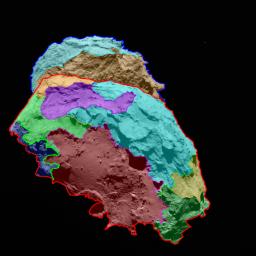
|
Distinct Terrains on Rosetta’s Comet
- Click the image above for a larger view
- Full-Res JPEG (2048 x 2048) (367.4 kB)
- Full-Res TIFF (2048 x 2048) (12.6 MB)
Caption:
This view of the "belly" and part of the "head" of comet 67P/Churyumov-Gerasimenko indicates several morphologically different regions.
Scientists have analyzed images of the comet's surface taken by OSIRIS, Rosetta's scientific imaging system, and defined several different regions, each of which has a distinctive physical appearance. This analysis provides the basis for a detailed scientific description of 67P's surface.
The comet has areas dominated by cliffs, depressions, craters, boulders and even parallel grooves. While some of these areas appear to be quiet, others seem to be shaped by the comet's activity, in which grains emitted from below the surface fall back to the ground in the nearby area.
As both comet 67P and Rosetta travel closer to the sun during the next few months, the OSIRIS team and other instruments on the payload will monitor the surface to look for changes. While scientists do not expect the borderlines they have identified for the comet's various regions to vary dramatically, even subtle transformations of the surface may help to explain how cometary activity created such a breathtaking world.
Background Info:
The scientific imaging system, OSIRIS, was built by a consortium led by the Max Planck Institute for Solar System Research (Germany) in collaboration with Center of Studies and Activities for Space, University of Padua (Italy), the Astrophysical Laboratory of Marseille (France), the Institute of Astrophysics of Andalusia, CSIC (Spain), the Scientific Support Office of the European Space Agency (Netherlands), the National Institute for Aerospace Technology (Spain), the Technical University of Madrid (Spain), the Department of Physics and Astronomy of Uppsala University (Sweden) and the Institute of Computer and Network Engineering of the TU Braunschweig (Germany). OSIRIS was financially supported by the national funding agencies of Germany (DLR), France (CNES), Italy (ASI), Spain, and Sweden and the ESA Technical Directorate.
Rosetta is an ESA mission with contributions from its member states and NASA. Rosetta's Philae lander is provided by a consortium led by the German Aerospace Center, Cologne; Max Planck Institute for Solar System Research, Gottingen; French National Space Agency, Paris; and the Italian Space Agency, Rome. JPL, a division of the California Institute of Technology, Pasadena, manages the U.S. participation in the Rosetta mission for NASA's Science Mission Directorate in Washington.
For more information on the U.S. instruments aboard Rosetta, visit http://rosetta.jpl.nasa.gov .
More information about Rosetta is available at: http://www.esa.int/rosetta .
For publicly released image use, see ESA's Copyright Notice Images .
Cataloging Keywords:
| Name | Value | Additional Values |
|---|---|---|
| Target | 67P/Churyumov-Gerasimenko | |
| System | Periodic Comets | |
| Target Type | Comet | |
| Mission | Rosetta | |
| Instrument Host | Rosetta Orbiter | Philae Lander |
| Host Type | Orbiter | Lander |
| Instrument | Optical, Spectrocopic and Infrared Remote Imaging System (OSIRIS) | |
| Detector | ||
| Extra Keywords | Color, Crater, Infrared | |
| Acquisition Date | ||
| Release Date | 2014-09-11 | |
| Date in Caption | ||
| Image Credit | Copyright: ESA/Rosetta/MPS for OSIRIS Team/MPS/UPD/LAM/IAA/SSO/INTA/UPM/DASP/IDA | |
| Source | photojournal.jpl.nasa.gov/catalog/PIA18429 | |
| Identifier | PIA18429 | |
